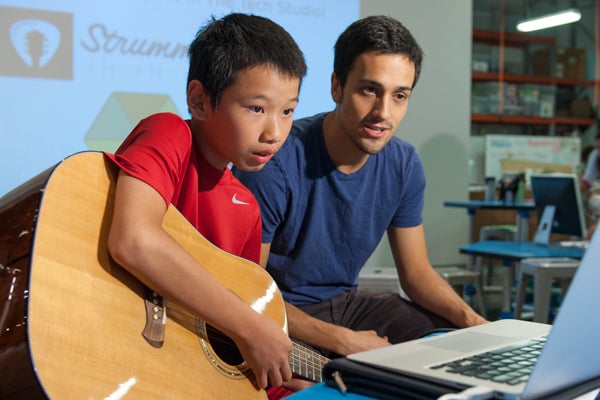|
July 29, 2013
Cool learning tools to be showcased at Stanford Aug. 2
Students in the Stanford Graduate School of Education are putting the finishing touches on projects for the 16th annual Learning, Design and Technology Expo, which will be held on campus Aug. 2. The Tech Museum of Innovation recently showcased some of the projects. By Kathleen J. Sullivan

Guitar novice Jim Huang, 12, follows the instructions on the interactive web application called Strummify, designed by graduate student Danny Cochran, right. (Linda A. Cicero / Stanford News Service)
Sitting on a stool and staring intently at a laptop screen, Jim Huang plucked out the melody of Happy Birthday and the rock song Circuital on a guitar – an instrument he was playing for the first time during a recent visit to The Tech Museum of Innovation in San Jose, Calif.
The seventh grader was following the instructions of Strummify under the watchful eye of Danny Cochran, a student in Stanford's Learning, Design and Technology (LDT) master's program at Stanford Graduate School of Education (GSE).
"Jim must have played Happy Birthday four or five times, so I decided he should play a harder song – Circuital by My Morning Jacket," said Cochran, who co-developed Strummify – a free web application that's billed as a "personal guitar tutor" – as a master's project.
"It's not an especially hard riff to play, but for a beginner who has never held a guitar before, it should definitely take a few days to master. He had it down in about five minutes. To be fair, I won't give all the credit to the software. It's clear Jim is a really smart kid, and his aunt told me he had musical experience with the violin."
Cochran was one of several GSE students who gave museum visitors the chance to try out five new educational technology products they had designed as capstone projects during the yearlong master's program. The projects are designed to offer creative technological solutions to important and interesting learning problems.
Karin Forssell, director of the LDT program, said the master's project is a cornerstone of the program.
"By designing and prototyping real-world solutions, students learn a lot about the learners they're designing for, their goals, constraints and needs," she said. "By testing prototypes, they challenge their assumptions and look for impact. Not just a 'cool tool,' but something that makes a difference."
The GSE students displayed their wares during Beta Jam, a museum program that provides sneak peeks at new "edtech" tools and offers developers the chance to get feedback from first-time users. Sitting at bright blue tables, students invited visitors to pull up a stool and join in the fun.
Cochran's goal was to design a free alternative to expensive music education software – programs he said often require buying additional equipment and hiring an instructor.
"From watching Jim and others play, I learned that my initial assumptions about an interface that incorporates existing styles of tablature – a form of musical notation indicating instrument fingering rather than musical pitches – is a strong fit for beginning guitar players," he said. "I also noticed that individuals who had some previous background in music, or had once tried to play guitar but never mastered it, were the most likely to enjoy the product and find it helpful."
At a nearby table, Stanford students Laura Bruursema and Kirti Patel demonstrated DesignDuo, a do-it-yourself design kit for daughters and dads to explore new technologies and create cool gadgets together – from a light box to a lamp – following instructions on flash cards or an iPad mini.
The kits combine art and design with elements of science and technology, and offer fathers and daughters the chance to build relationships by building something together.
Twelve-year-old Julianna Pereira and her engineer father, Frank Pereira, who were visiting the museum from Pleasanton, Calif., sat down to create a light box – a project that took about 20 minutes.
"Frank told us he learned from his daughter to follow instructions," Bruursema said. "He also learned that his daughter could be interested in and capable of activities that build engineering and design skills."
Patel said watching Julianna and Frank interact reinforced the students' belief that fathers have just as much to learn from their daughters as daughters can learn from their dads.
"This was an important insight, and we want to build those these types of interactions into our learning design," she said.
In addition to Strummify and DesignDuo, the event showcased:
- Worlds: a social web platform for middle school students to learn programming concepts by crafting and exploring virtual worlds.
- What If: a toolkit that allows individuals to use different sensors to control everyday appliances, to help them see how programming fits into their lives.
- Horse Sense Problem Solver: a web-based tool featuring a palomino horse that helps individuals approach problems from a fresh perspective by asking a series of problem-solving questions.
All of the projects – and seven more – will be on display Aug. 2 from 4 to 6:30 p.m. at the Learning, Design & Technology Expo, which will be held at the Center for Educational Research at Stanford (CERAS), located at 520 Galvez Mall. The event is free and open to the public.
-30-
|